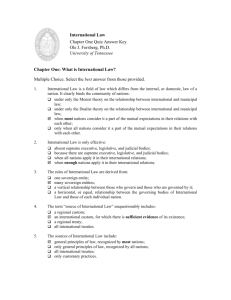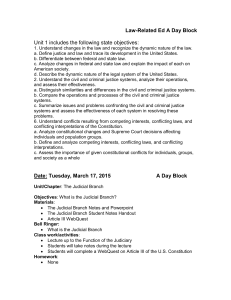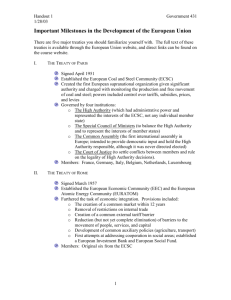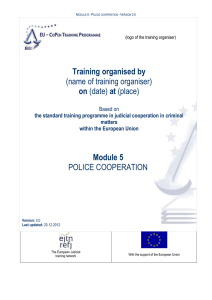meral tejeci
advertisement
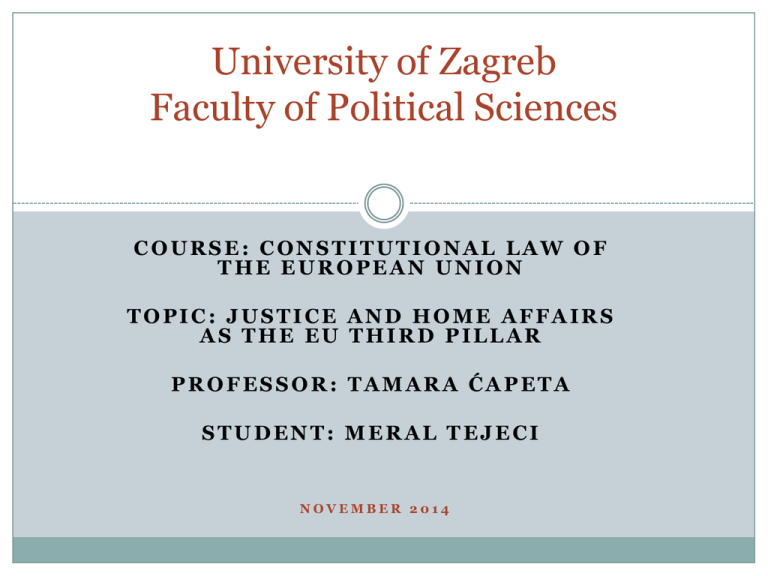
University of Zagreb Faculty of Political Sciences COURSE: CONSTITUTIONAL LAW OF THE EUROPEAN UNION TOPIC: JUSTICE AND HOME AFFAIRS AS THE EU THIRD PILLAR PROFESSOR: TAMARA ĆAPETA STUDENT: MERAL TEJECI NOVEMBER 2014 JUSTICE AND HOME AFFAIRS Historical aspects of the pillar Police and Judicial cooperation between member states European Judicial Network Europol and Eurojust Historical aspects The multilateral cooperation of the member states regarding their homeland security, especially the police and judicial crime fighting, started on different levels and in special subject matters on the basis of different legal foundations and instruments. There was no reference to JHA in the Treaty of Rome. But the cooperation of the member states developed on a bilateral, regional and international level. More active than Community was the Council of Europe, which addressed many issues related criminal matters and human rights, supported international conventions on extradition and hosted meetings with national government ministers dealing with internal affairs to take more multinational approach to their tasks. The first step In 1967 was signed the Naples Convention on cooperation between the customs authorities of Community. This convention provided for cross border supervision of criminal suspects by national police and customs authorities . Its key contribution was to encourage exchanges and cooperation between national governments. This convention was superseded in 1997 by the Convention on mutual assistance and cooperation between customs administration of EU, otherwise known as Naples II. Next step In 1971 the Pompidou group , named for French President Georges Pompidou was set up to share experiences on the combatting of drug use and trafficking This was followed in 1975 by creation of the TREVI group , set up to coordinate antiterrorist activities, expanding after 1985 to include drug trafficking and organized crime. Trevi was an intergovernmental network - or forum - of national officials from ministries of justice and the interior outside of the European Community framework created during the European Council Summit in Rome, 1–2 December 1975 TREVI- Terrorism, Radicalism, Extremism and International Violence (1975) The creation of TREVI was prompted by several terrorist acts, most notably the hostage taking and consequent massacre during the 1972 Olympic Games in Munich, and the inability of Interpol at that time to effectively assist the European countries in their combat against this terrorism. It ceased to exist when it was integrated in the so-called Justice and Home Affairs (JHA) pillar of the European Union (EU) upon into force of the Treaty of Maastricht in 1992. Another initiative for cooperation on JHA came from the 1985 Schengen Agreement , the implementation of which helped begin the process of harmonizing policies on visas, illegal immigration , asylum, extradition, police and judicial cooperation The Maastricht Treaty-Incorporation of JHA in the third pillar Since the adoption of the Treaty of Maastricht, the EU has been pictured as a Greek temple. With the Maastricht Treaty the European Union (EU) legally comprised three pillars. Justice and Home Affairs pillar was established with the Maastricht Treaty , which has at heart been an effort to create an area of freedom, security and justice within the EU. European Union: three pillars The Amsterdam Treaty and EU pillars Amendments by the treaty of Amsterdam and the treaty of Nice made the additional pillars increasingly supranational. Most important among these were the transfer of policy on asylum, migration and judicial co-operation in civil matters to the Community pillar, effected by the Amsterdam treaty. Thus the third pillar was renamed Police and Judicial Co-operation in Criminal Matters, or PJCC. The term Justice and Home Affairs was still used to cover both the third pillar and the transferred areas. The three pillars functioned on the basis of different decisionmaking procedures: the Community procedure for the first pillar and the intergovernmental procedure for the other two. After the Lisbon Treaty In a speech before the Nice Conference, Joschka Fischer, then Foreign Minister of Germany, called for a simplification of the European Union. One of the core ideas was to abolish the pillar structure, and replace it with a merged legal personality for the Union. This idea was included in the Treaty of Lisbon, which entered into force on 1 December 2009 Decisions are taken in accordance with a procedure called the “ordinary legislative procedure”. However, the intergovernmental method continues to apply to the Common Foreign and Security Policy. European Judicial Network The European Judicial Network (EJN) is a network of national contact points for the facilitation of judicial cooperation in criminal matters between Member States by improving communication between the contact points, by organising regular meetings for the representatives of Member States and by providing the necessary background information. Founded in 1997 – The EJN is composed of Contact Points of the Member States, as well as of the European Commission and of a Secretariat based in Hague. National contact points are appointed by each Member State among Central authorities in charge of international judicial co-operation Is administrated by Sekretariat EUROPOL Europol is the European Union’s law enforcement agency, whose main goal is to help achieve a safer Europe for the benefit of all EU citizens. Assisting the European Union’s Member States in their fight against serious international crimes and terrorism. (in reality is a criminal intelligence organization like Interpol) The History of Europol TREVI Group – ideas for fighting the criminal activities Maastricht Treaty – harmonization of policies In 1993 was founded the Europol Drugs Unit (EDU), which started operating in January 1994, had no powers of arrest, but was mandated to assist national police forces in criminal investigations On 29 October 1993, the European Council decided that Europol should be established in The Hague. ‘legal capital of the world’ Where is also located the International Court of Justice and the International Criminal Tribunal for the former Yugoslavia Convention establishing Europol under Article K3 of the Maastricht Treaty was agreed in 1995 and after ratification by the Member States, came into force on 1 October 1998. Main goals Europol became fully operational on 1 July 1999 The main goals: To function as the principal EU support centre for law enforcement operations To become the criminal information centre of the European Union To develop further as an EU centre for law enforcement expertise Management and Control Europol is overseen by a Menagement Board – with one respresentative of each Member State The head of Europol is the Director, appointed by The Council, which is also responsible for the main control and guidance of Europol. The Council approves Europol’s budget (which is part of the general budget of the EU), together with the European Parliament. Together with the European Parliament, adopt regulations related to Europol’s work. The Europol reports to Justice and Home Affairs Council Eurojust- The Judicial Cooperation Unit The idea first was discussed at European Council Meeting in Tampere, Finland, on 15 and 16 October 1999 On 14 December 2000, on the initiative of Portugal, France, Sweden and Belgium, a provisional judicial cooperation unit was formed under the name ProEurojust, operating from the Council building in Brussels. ( started work on 1 March 2001) Establishment of Eurojust Council Decision 2002/187/JHA, of the establishment of Eurojust as a judicial coordination unit (terrorist attacs to US influenced to take serious steps in order to prevent this actions also in Europe) Set up in 2002, with headquarters in The Hague to improve investigation and and prosecutions involving two or more member states. Composed of national prosecutors, magistrates, or police officers of equivalent competence, detached from each Member State according to their own legal systems. It can stimulates and improves the coordination of investigations and prosecutions between the competent authorities in the Member States, but has no power for investigation and prosecution Competences Eurojust has the authority: To ask the national authorities to launch an investigation or start a prosecution To coordinate the work of multiple national authorities To set up joint investigation team Provide supporting information Eurojust has established contact points in 23 non-Member States: Albania, Argentina, Bosnia and Herzegovina, Canada, Egypt, the former Yugoslav Republic of Macedonia, Iceland, Israel, Japan, Korea, Liechtenstein, Moldova, Mongolia, Montenegro, Norway, Russian Federation, Serbia, Singapore, Switzerland, Thailand, Turkey, Ukraine and the USA. Eurojust maintains close cooperation and cooperation agreements with other bodies such as: European Anti-Fraud Office (OLAF), the European Judicial Training Network (EJTN), (CEPOL) European Police College, (FRONTEX) European Agency for the Management of Operational Cooperation at the External Borders of the Member States of the European Union. Conclusions Member States established and improved police and judicial cooperation between each other – one of the most important results has been the extension of the principle of mutual recognition to judicial matters EU has power and competent authorities to fight criminal actions. Legal basis regulating the area of police and judicial cooperation are found in legal provisions of the Lisbon Treaty (art. 65 -85) References Treaty of Lisbon, Official Journal of the European Union nr.C306, 2007, art. 65-85 McCormick John, European Union Politics, 2011, p.247-249, p.393407 Dinan Desmond, Ever Closer Union, 4th edition, 2010, p.540-542 http://europa.eu/ http://www.ejn-crimjust.europa.eu/ejn/ https://www.europol.europa.eu/ http://www.eurojust.europa.eu/Pages/home.aspx THANK YOU FOR YOUR ATTENTION

